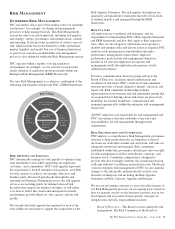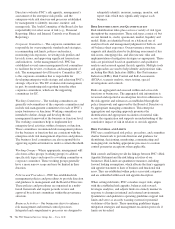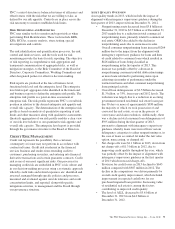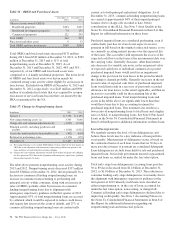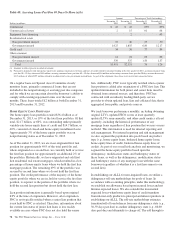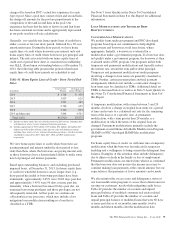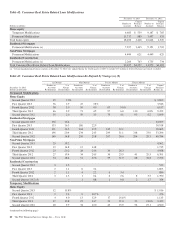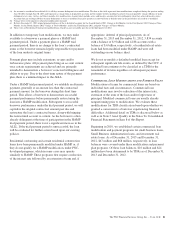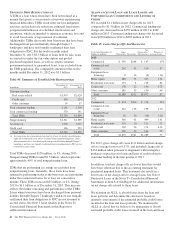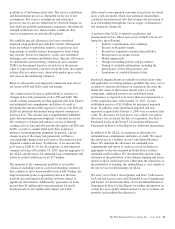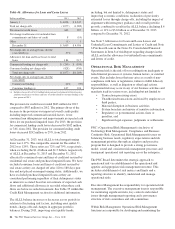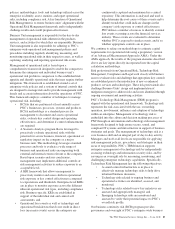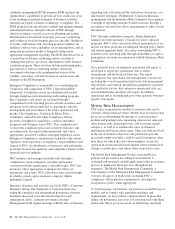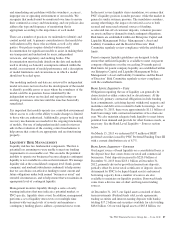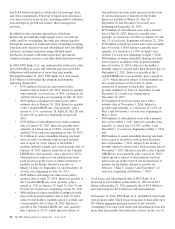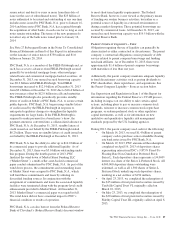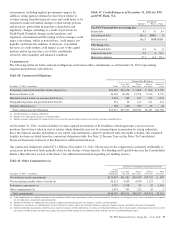PNC Bank 2013 Annual Report Download - page 99
Download and view the complete annual report
Please find page 99 of the 2013 PNC Bank annual report below. You can navigate through the pages in the report by either clicking on the pages listed below, or by using the keyword search tool below to find specific information within the annual report.(a) An account is considered in re-default if it is 60 days or more delinquent after modification. The data in this table represents loan modifications completed during the quarters ending
June 30, 2012 through June 30, 2013 and represents a vintage look at all quarterly accounts and the number of those modified accounts (for each quarterly vintage) 60 days or more
delinquent at six, nine, twelve, and fifteen months after modification. Account totals include active and inactive accounts that were delinquent when they achieved inactive status.
Accounts that are no longer 60 days or more delinquent, or were re-modified since prior period, are removed from re-default status in the period they are cured or re-modified.
(b) Vintage refers to the quarter in which the modification occurred.
(c) Reflects December 31, 2013 unpaid principal balances of the re-defaulted accounts for the Second Quarter 2013 Vintage at Six Months, for the First Quarter 2013 Vintage at Nine
Months, for the Fourth Quarter 2012 Vintage at Twelve Months, and for the Third Quarter 2012 and prior Vintages at Fifteen Months.
(d) There were no Residential Construction modified loans which became six months past due in the third quarter of 2012.
In addition to temporary loan modifications, we may make
available to a borrower a payment plan or a HAMP trial
payment period. Under a payment plan or a HAMP trial
payment period, there is no change to the loan’s contractual
terms so the borrower remains legally responsible for payment
of the loan under its original terms.
Payment plans may include extensions, re-ages and/or
forbearance plans. All payment plans bring an account current
once certain requirements are achieved and are primarily
intended to demonstrate a borrower’s renewed willingness and
ability to re-pay. Due to the short term nature of the payment
plan, there is a minimal impact to the ALLL.
Under a HAMP trial payment period, we establish an alternate
payment, generally at an amount less than the contractual
payment amount, for the borrower during this short time
period. This allows a borrower to demonstrate successful
payment performance before permanently restructuring the
loan into a HAMP modification. Subsequent to successful
borrower performance under the trial payment period, we will
capitalize the original contractual amount past due and
restructure the loan’s contractual terms, along with bringing
the restructured account to current. As the borrower is often
already delinquent at the time of participation in the HAMP
trial payment period, there is not a significant increase in the
ALLL. If the trial payment period is unsuccessful, the loan
will be evaluated for further action based upon our existing
policies.
Residential conforming and certain residential construction
loans have been permanently modified under HAMP or, if
they do not qualify for a HAMP modification, under PNC-
developed programs, which in some cases may operate
similarly to HAMP. These programs first require a reduction
of the interest rate followed by an extension of term and, if
appropriate, deferral of principal payments. As of
December 31, 2013 and December 31, 2012, 5,834 accounts
with a balance of $.9 billion and 4,188 accounts with a
balance of $.6 billion, respectively, of residential real estate
loans had been modified under HAMP and were still
outstanding on our balance sheet.
We do not re-modify a defaulted modified loan except for
subsequent significant life events, as defined by the OCC. A
modified loan continues to be classified as a TDR for the
remainder of its term regardless of subsequent payment
performance.
C
OMMERCIAL
L
OAN
M
ODIFICATIONS AND
P
AYMENT
P
LANS
Modifications of terms for commercial loans are based on
individual facts and circumstances. Commercial loan
modifications may involve reduction of the interest rate,
extension of the term of the loan and/or forgiveness of
principal. Modified commercial loans are usually already
nonperforming prior to modification. We evaluate these
modifications for TDR classification based upon whether we
granted a concession to a borrower experiencing financial
difficulties. Additional detail on TDRs is discussed below as
well as in Note 5 Asset Quality in the Notes To Consolidated
Financial Statements in Item 8 of this Report.
Beginning in 2010, we established certain commercial loan
modification and payment programs for small business loans,
Small Business Administration loans, and investment real
estate loans. As of December 31, 2013 and December 31,
2012, $47 million and $68 million, respectively, in loan
balances were covered under these modification and payment
plan programs. Of these loan balances, $16 million and $24
million have been determined to be TDRs as of December 31,
2013 and December 31, 2012.
The PNC Financial Services Group, Inc. – Form 10-K 81


